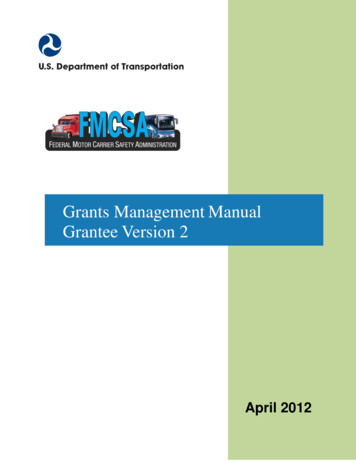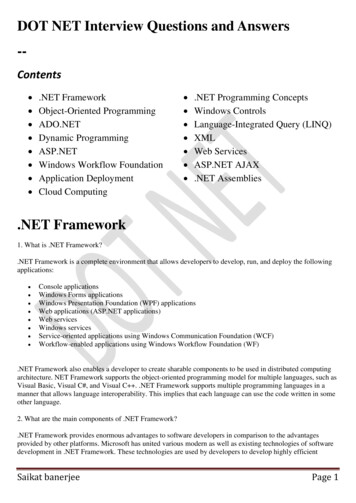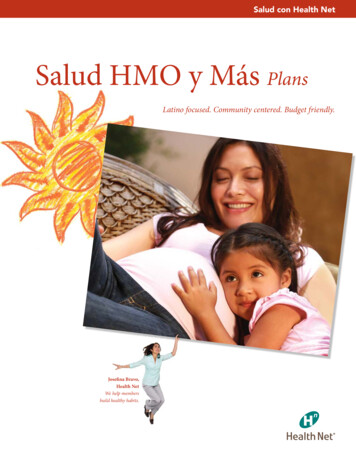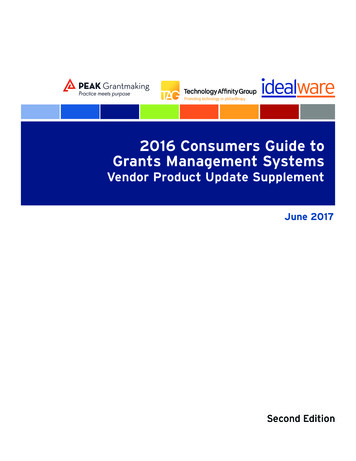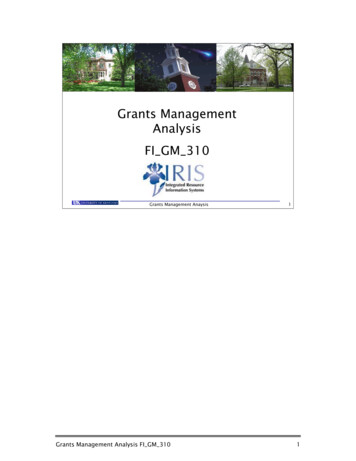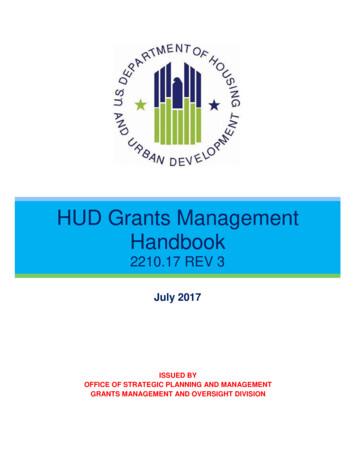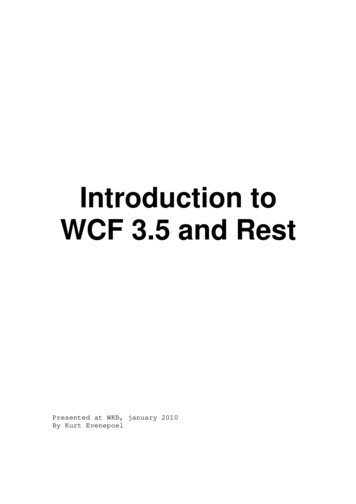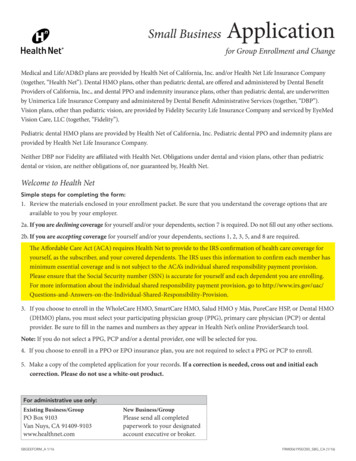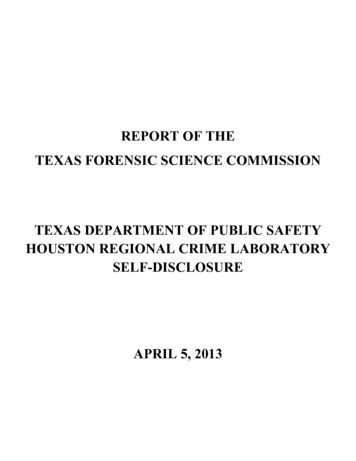
Transcription
UNIVERSITY GRANTS COMMISSIONNET BUREAUSYLLABUSSubject: YogaCode No. : 1001. Fundamentals of Yoga: History and Various Schools of Yoga2. Yoga Texts – I : Principal Upanishads, Bhagavad Gita and Yoga Vasishtha,3. Yoga Texts – II : Yoga Upanishads4. Patanjal Yoga Sutra5. Hatha Yoga Texts6. Allied Sciences: General Psychology, Human Biology, Diet & Nutrition7. Yoga and Health8. Therapeutic Yoga9. Applications of Yoga10. Practical Yoga – Shatkarma, Asana, Pranayama, Mudra, Bandha, Dhyana, SuryaNamaskaraUNIT- IFundamentals of Yoga: History and Various Schools of Yoga History and Development of Yoga; Meaning & Definitions, Misconceptions, Aim andObjectives of Yoga.Introduction to Vedas, Upanishads and Prasthanatrayee; Concept of Purushartha ChatushtayaBasic concepts of Shad-darshanas- Epistemology, Metaphysics, Ethics and Liberation withspecial emphasis to Samkhya, Yoga and Vedanta Darshana.Introduction to Epics and Smriti- yoga in Ramayana (Aranyakand), Mahabharata(Shantiparva) and Yajnavalkya SmritiBrief introduction and yogic contribution of Maharshi Patanjali and Guru GorakshanathTraditions.Yoga in Narada Bhaktisutra and Yoga in the Literature of Saints- Kabirdas, Tulasidas andSurdas.Yoga in Modern Times: Yogic Traditions of Swami Vivekananda, Shri Aurobindo;Maharshi Ramana and Maharshi Dayanand SaraswatiYoga in Contemporary Times: Brief Introduction of Sri Shyamacharan Lahidi ,Sri T.Krishnamacharya, Swami Shivanada Saraswati, Swami Rama of Himalayas, Maharshi1
Mahesh Yogi, Pt. Sri Ram Sharma Acharya and their contribution for the development andpromotion of Yoga.Introduction to Jnanayoga, Bhaktiyoga, Karmayoga, Rajayoga, Hathayoga and Mantra YogaElements of Yoga in Jainism and Buddhism.UNIT- IIYogic Texts- I: Principal Upanishads, BhagavadGita, Yoga VasishthaPrincipal UpanishadsBrief Introduction of Ten Principal Upanishads.Ishavasyopanishad:Concept of Karmanishta; Concept of Vidya and Avidya; Knowledge ofBrahman; Atma Bhava.KenaUpanishad: Self and the Mind; Intuitive realization of the truth; Moral of YakshaUpakhyana.KathaUpanishad: Definition of Yoga; Nature of Soul; Importance of Self Realization.Prashna Upanishad: Concept of Prana and rayi (creation); Panchapranas; The six mainquestions;Mundaka Upanishad: Two approaches to Brahma- Vidya- Para and Apara; The greatness ofBrahmavidya; Worthlessness of Selfish-karma; Tapas and Gurubhakti; The origin of creation,the ultimate aim of Meditation- Brahmanubhuti.Mandukya Upanishad: Four States of Consciousness and their relation to syllables in Omkara.Aitareya Upanishad: Concept of Atma, Universe and Brahman.Taittiriya Upanishad: Concept of Pancha Kosha; Summary of Shiksha Valli, AnandaValli,Bhriguvalli.Chhandogya Upanishad: Om (udgitha) Meditation; Shandilyavidya.Brihadaranyaka Upanishad: Concept of Atman and Jnana Yoga; Union of Atman andParamatmanBhagavad GitaGeneral Introduction to Bhagavad Gita, Definitions of Yoga, their relevance & Scope; Essentialsof Bhagavad Gita - meanings of the terms Atmaswarupa, Stithaprajna, Sankhya Yoga (Chpt.II),Karma Yoga (Chpt.III ), Samnyasa Yoga and Karma Swarupa (Sakama and Nishkama)Samnyasa, Dhyana Yogas (Chpt. VI); Types of Bhakta(Chpt. VII) Nature of Bhakti (Chpt.XII),Means and End of Bhakti-Yoga; The Trigunas and nature of Prakriti; Three Kinds of Faith. Foodfor Yoga-Sadhaka, Classification of food (Chpt.XIV & XVII) Daivasura-Sampad-Vibhaga Yoga(Chpt.XVI);Moksa-SamnyasaYoga (Chpt. XVIII)2
Yoga Vasishtha:Salient features of Yoga Vashitha, Concept of Adhis and Vyadhis; Psychosomatic Ailments; Thefour Dwarpaals to Freedom; How Sukha is attained in the Highest State of Bliss; Practices toovercome the Impediments of Yoga; Development of Satvaguna; Eightlimbs of Meditation;Jnana Saptabhumika.UNIT- IIIYogic texts- II: Yoga Upanishads: Swetaswataropanishad: (Chapter II) Techniques and Importance of Dhyanyoga,suitable place for Dhyana, sequence of pranayama & its importance, Prior symptoms ofYogasiddhis, Importance of Yogasiddhis , Tattvajna, (ChapterVI) Nature of God,techniques for Realization, Attainment of liberation.Yogakundali Upanishad: Methods of Pranayama Siddhi, Types of Pranayama, meansof Self -realization.Yogachudamadi Upanishad: The description of the six limbs of yoga, their results andsequence Trishikhibrahmanopanishad: description of Ashtangayoga, Karmayoga andJnanayoga.Yogatattva Upnishad: Mantrayoga, Layayoga, Hathyoga, Rajayoga and their stages,diet and Dincharya, primary symptoms of yoga siddhis and precautions.Dhyanbindoopanishad: importance of Dhyanayoga, Nature of Pranav, Techniques ofPranav meditation, Shadangyoga, Atmadarshan through Nadanusandhan.Nadabindoopanishad: Hansavidya : description of various limbs of Omkar, 12 matrasof omkar and its results of their application with Pranas, Types of nadas, nature ofnadanusandhan sadhana, state of Manolaya.Yogarajopnishad: Mantrayoga, Layayoga, Hathayoga, Rajayoga, nine chakras,procedures of Dhyana and its results.UNIT- IVPatanjala Yoga Sutra:SAMADHI PAADA : Yoga, meaning & Nature of yoga; Concept of Chitta, Chitta-Bhumis,Chitta-Vrittis, Chitta-Vrittinirodhopaya, Abhyasa and Vairagya as the tools, Concept ofBhavapratyaya & Upaypratayaya, Sadhan Panchak, Chitta-Vikshepas (Antaraya), EktattvaAbhyasa,Chitta-prasadanam. Types and nature of Samadhi: Adhyatmaprasada andRitambharaprajna; Samprajnata, Asamprajnata, Sabeeja & Nirbeeja Samadhi, Differencebetween Samapattis and Samadhi; Concept of Ishwara and attributes of Ishwara, Process ofIshwarapranidhana.SADHANA PAADA: Concept of Kriya Yoga , theory of Kleshas ; Concept of Karmashaya andKarmvipaka, Nature of dhukha, Concept of Chaturvyuhavada, Drishyanirupanam,3
Drasthanirupanam, Prakriti-Purusha Samyoga; Brief Introduction to Ashtanga Yoga; YamaNiyama; Concept of Vitarka & Mahavrata; Asana, Pranayama, Pratyahara and their siddhis.VIBHUTI PAADA: Introduction of Dharana, Dhyana and Samadhi, Nature of Sanyama;Concept of Chitta samskara, Parinamatraya and vibhutis.KAIVALYA PAADA: Five means of Siddhis, concept of Nirman Chitta, Importance of siddhisachieved through Samadhi, Four types of Karmas; Concept of Vasana; Dharmamegh Samadhiand its result, Viveka Khyati Nirupanam, Kaivalya Nirvachana.UNIT-VHatha Yoga texts Introduction to Hatha Yoga and Hatha Yoga Texts. Yoga Beeja, Goraksha Samhita,Vashishtha Samhita, Shiva Samhita, Siddhasiddhantapaddhati, Hatha Pradeepika, GherandaSamhita and Hatha Ratnavali. Aim & objectives,misconceptions about Hathayoga, prerequisitesof Hathayoga (dasha yama and dasha niyama),Sadhaka and Badhaka tattvas in Hathayoga;Concept of Ghata, Ghatashuddhi, Concept and importance of Shodhana kriyas in Hathayoga;Importance of Shodhana kriyas in health and disease; Concept of Matha, Mitaahara, Rules &Regulations to be followed by Hatha Yoga Sadhakas; Asanas in Hatha Texts: Definition, pre requisites and special features of Yoga-asana; Asanasin Hatha Pradeepika, Hatha Ratnavali, Shiv Samhita, Vasishtha Samhita,Gheranda Samhitabenefits, precautions and contra indications of different Asanas; Pranayama in Hatha Texts: - Concept of Prana and Pranayama; Pranayama-its phases andstages; Prerequisites of Pranayama in Hathayoga Sadhana; Pranayama in Hatha Pradeepika,Gheranda Samhita; Shiv Samhita, Vashishtha Samhita-benefits, precautions and contraindications of different Pranayama. Bandha, Mudra and other practices: Concept and definition of Bandha and Mudras in HathaPradeepika, Hatha Ratnavali and Gheranda Samhita; Shiv Samhita, Vashishtha Samhitabenefits, precautions and contra indications. Concept, definition, benefits and Techniques ofPratyahara, Dhyana in Gheranda Samhita; Concept and benefits of Nada and Nadanusandhanain Hatha Pradeepika, Four (stages) Avasthas of Nadanusandhana; Relationship between HathaYoga and Raja Yoga; Goal of Hatha Yoga. Relevance of Hatha Yoga in contemporary times.UNIT-VIGeneral Psychology Introduction to Altered States of ConsciousnessSleep: Stages of Sleep, Sleep Disorders; Behavioural Psychology: Psychology as a Science of Behaviour; Psychological basis ofbehaviour;4
Personality: Nature and Types of Personality; Determinants of Personality: Heredityand Environment; Facets and Stages of Personality Development; Cognitive Psychology: Sensation, Perception, Attention, Memory, Learning :- Theirdefinitions and types,Mental Health; Causes and Consequences of Mental Conflicts and Frustrations;Introduction to Common mental disorders: Insomnia, Depression, Stress, Anxiety disordersIntroduction to Human Anatomy and Physiology Introduction to cell, tissue, organs and systems; Basic cell physiology-CellIntroduction, Cell Organelles, Cell membrane, Movement of the substances and waterthrough the cell membrane, Bioelectric potentials.Musculoskeletal systems: Skeleton - names of all bones, joints and muscles, cartilage,tendon and ligaments, types of bone, joints and their functions; spine, muscles andtheir functions; Skeletal muscles - Properties of skeletal muscles, Muscular contractionand relaxation, Neuromuscular junction, Sarcotubular system, Smooth musclemechanism of contractionDigestive and excretory system: Anatomy of digestive system, excretory system(component organs) and their functions; Gastro intestinal system- General structure ofalimentary canal, Gastric secretion, Pancreatic secretion, Gastric motility-digestiveperistalsis Gastrointestinal hormones.Renal physiology- Structure of kidney, Nephrons, Juxtra glomerular filtrate,Reabsorption, Secretion-mechanism of secretion, Concentrating and dilutingmechanism of urine, DialysisNervous system and glands: Structure and properties of neurons, subdivisions ofnervous system and their functions, types of glands (endocrine and exocrine glands),important endocrine and exocrine glands and types of hormones their functions.Sensory nervous system, Motor nervous system, Higher functions of the nervoussystem, Synapse, Reflexes Cerebrospinal fluid, Blood brain and blood CSF barrierCardiovascular and respiratory system: Components of cardiovascular and respiratorysystem; functions of cardiovascular and respiratory system; Circulatory systemFunctional anatomy of the heart, Properties of cardiac muscles, Conducting system ofthe heart, Pressure changes during cardiac cycles, Capillary circulation, Arterial andvenous blood pressure; Respiratory system-Mechanism of breathing, Ventilation,Regulation of respiration, Transport of gases, Hypoxia, Artificial ventilation, Nonrespiratory functions of the lungsImmune system: Component organs of immune system, Functions of immune system;Endocrinology-Endocrine glands, hormones, their functions;Reproductive system: Anatomy of male and female reproductive systems5
Diet and Nutrition Basic concepts and components of food and nutrition Understanding Nutrition, BasicTerminology in Relation to Nutrition Requirement, Human Nutritional Requirements;Concept of food, Acceptance of Food, Functions of Food; Components of Food & theirClassification; Macro Nutrients –Sources, Functions and Effects on the Body; MicroNutrients - Sources, Functions and Effects on the Body; Fat Soluble Nutrients - Sources,Functions and Effects on the Body; Water soluble Nutrients - Sources, Functions andEffects on the Body; Significance of Carbohydrate, Proteins, Lipids, Vitamins, Mineralsand water, Excessive and deficiency diseases of nutrients in the body; Antioxidants andtheir Role; Yogic concept of diet and its relevance in the management of lifestyle Nutrients, proximate principles of diet, balanced diet concept; Carbohydrates, proteins,fats – sources, nutritive values, importance; Minerals-calcium, iron, phosphorus etc.Vitamins – sources, roles, requirements Food groups.Cereals & Millets –Selection, Preparation and Nutritive Value; Pulses, Nuts and OilSeeds- Selection, Preparation and Nutritive Value; Milk and Milk Products- Selection,Preparation and Nutritive Value; Vegetables and Fruits- Selection, Preparation andNutritive Value, Fats, Oils and Sugar, Jaggery, Honey, sprouts- Selection, Preparation andNutritive Value Food and metabolism. Energy- Basic Concepts, Definition and Components of EnergyRequirement, Energy Imbalance Concept of Metabolism, Anabolism, Catabolism, CalorieRequirement-BMR, SDA, Physical Activity; Metabolism of Carbohydrates, Lipids andProtein; Factors Affecting Energy; Requirement and Expenditure, Factors affecting BMR.UNIT-VIIYoga and Health Definition & Importance of Health According to WHO; Dimensions of Health: Physical,Mental, Social and Spiritual; Concepts of Trigunas, Pancha-mahabhutas, Pancha-prana and their role in Health andHealing; Concept of Pancha-koshas & Shat-chakra and their role in Health and Healing; Role of Yoga in preventive health care – Yoga as a way of life, Heyamdukhamanagatam;Potential causes of Ill-health: Tapatrayas and Kleshas, Physical and Physiologicalmanifestation of Disease: Vyadhi, Alasya, Angamejayatva and Ssvasa-prashvasa. Mental and Emotional ill Health: Styana, Samshaya, Pramada, Avirati, Bhranti-darsana,Alabdha-bhumikatva, Anavasthitatva, Duhkha and Daurmanasya6
Yogic Diet - General Introduction of Ahara; Concept of Mitahara; Classification in Yogicdiet according to traditional Yoga texts; Diet according to the body constitution (Prakriti)– Vata, Pitta and Kapha as also Gunas. Concepts of Diet: Pathya and Apathya according to Gheranda Samhita,Hathapradeepikaand Bhagavad Gita; Importance of Yogic Diet in Yog Sadhana and itsrole in healthy living; Diet according to the body constitution ( Prakriti) – Vata, Pitta andKapha as also Gunas. Yogic Principles of Healthy Living: Ahara, Vihara, Achara and Vichara; Role of YogicPositive Attitudes (Maitri, Karuna, Mudita and Upeksha) for Healthy Living, Concept ofBhavas and Bhavanas with its relevance in Health and well-beingUNIT-VIII Therapeutic Yoga –Yogic Practice - Management of the diseases through suitable yogic practices - Yogicdiet, Yama and Niyama, Shatkarma, Asanas, Pranayama; Meditation; changes in lifestyleaccording to yogic scriptures. Integrated Approach of Yoga therapy for the following Common Ailments: Respiratory disorders - Allergic Rhinitis & Sinusitis:asthama Cardiovascular disorders: Hypertension, Angina pectoris, Cardiac asthma:Chronic Bronchitis, Bronchial Endocrinal and Metabolic Disorder - Diabetes Mellitus, Hypo and Hyper- Thyroidism;Obesity: Metabolic Syndrome Obstetrics and Gynecological Disorders, Menstrual Disorders: Dysmenorrhea,Menopause and peri-menopausal syndrome: Yoga for Pregnancy and Childbirth, Antenatal care, Post-natal care. Gastrointestinal Disorders:Gastritis, Indigestion, Peptic Ulcers, Constipation,Diarrhoea, Irritable Bowel Syndrome, colitis, Piles. Muscular-Skeletal Disorders: Back Pain, Intervertebral disc prolapse (IVDP) LumbarSpondylosys, Cervical Spondylosis, , Arthritis Neurological Disorders: Migraine, Tension-headache, Epilepsy Psychiatric Disorders: Neurosis, Anxiety disorders, Phobias, Depression.7
UNIT-IXApplications of Yoga Applied Philosophy: Yoga as Applied philosophy; Meaning, definition and nature ofconsciousness as described in Vedas,, Upanishads, Bhagwad Gita, Yogasutra andYogavashishtha; Spiritual and scientific approach to human consciousness. YogicMethod of elevation of human consciousness: Bhaktiyoga, Jnanyoga, Karmayoga,Mantrayoga, Ashtangayoga, Hathayoga. Yoga in Education: Salient features of Yoga Education, Factors of Yoga Education;Teacher, Student and Teaching, Value based education- Meaning and definition, types ofvalues. Teaching Methodology in Yoga: Teaching and Learning: Concepts and Relationshipbetween the two; Principles of Teaching: Meaning and scope of Teaching methods andfactors influencing them; Teaching techniques- Individual, group and mass Essentials of Good Lesson Plan: concepts, needs, planning of teaching Yoga(Shodhanakriya, Asana, Mudra, Pranayama & Meditation) Models of Lesson Plan; need for a lesson plan and content plan; Eight Step method ofIntroduction as developed in Kaivalyadhama. Evaluation methods of an ideal Yoga class; Methods of customizing Yoga class to meetindividual needs. The student will have demonstrations and training in the abovementioned aspects of teaching methods. Yoga classroom: Essential features, Area, Sitting arrangement in Yoga class, Student’sapproach to the teacher: Pranipaata; Pariprashna; Seva; (BG 4.34)UNIT-XPractical YogaYogic Practices – Shatkarma, Asana, Pranayama, Mudra, Bandha, Dhyana, SuryaNamaskara (Techniques, Salient Features, Benefits) Shatkarmas: Vamandhauti, Vastradhauti, Dandadhauti, Laghoo and Poornasankhaprakshalana, Neti (Sutra and Jala), Kapalbhati(Vaatkrama,Vyutakrama &Sheetkarma), Agnisara, Nauli, Tratak Suryanamaskar- Suryanamaskar must be practiced traditionally Asanas (yogic postures) Standing Postures-Ardhakatichakrasana, Padahastasana,Ardhachakrasana, Trikonasana, Parivrittatrikonasana, Parsvakonasana, Veerasana. rdhamatsyendrasana,Vakrasana, Baddhakonasana, Merudandasana, Akarnadhanurasana, Gomukhasana, Prone postures- Bhujangasana, Shalabhasana, Dhanurasana, Urdhvamukhosvanasana,Makarasana,8
Supine postures- Halasana, Chakrasana, Sarvangasana, Matsyasana, Shavasana,Setubandhasana, Balancing asana,Tittibhasana, Pranayama: Breath awareness, Sectional breathing, Nadishuddhi, Suryabhedan, , Ujjai ,Sitali, Sitkari, Bhastrika, Bhramari, Bahyavritti, Abhyantarvritti, Stambhavritti Pranayama Practices leading to Meditation: Pranav and Soham Japa, Yoga Nidra, Antarmauna,Ajapa Jap, Practices leading to Breath Meditation, Practices leading to Om Meditation,Practices leading to Vipassana Meditation, Practices leading to Preksha Meditation Bandhas and Mudras: Mula Bandha, Jalandhara Bandha, Uddiyana Bandha, MahaBandha, Yoga Mudra, Maha Mudra, Shanmukhi Mudra, Tadagi Mudra, VipareetKarniMudra Contemporary Yogic Practices – Yogic Sukshma Vyayama (Swami DheerandraBrahmchari), Cyclic Meditation (S-VYASA); Mind Sound Resonance Technique (SVYASA); Transcendental Meditation (Maharshi Mahesh Yogi); Yoga Nidra (BSY); Savita KiDhyan Dharana (DSVV).9
Subject: Yoga Code No. : 100 1. Fundamentals of Yoga: History and Various Schools of Yoga 2. Yoga Texts – I : Principal Upanishads, Bhagavad Gita and Yoga Vasishtha, 3. Yoga Texts – II : Yoga Upanishads 4. Patanjal Yoga Sutra 5. Hatha Yoga Texts 6. Allied Sciences: General Psychology, Human Biology, Di
